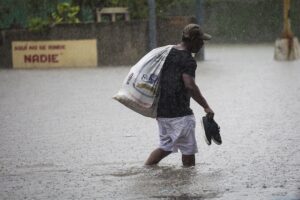
Next Wednesday (3), first thing in the morning, thousands of laid-off Argentine state employees will try to return to work in a coordinated manner. This is the measure that the State Workers’ Association (ATE) decided to deal with an as yet undetermined number of workers whose contracts were not renewed as of April 1st.
The president, Javier Milei, boasted to businesspeople gathered at the AmCham conference about the dismissal of 70,000 workers. of March. Of this total, said the presidency spokesman, Manuel Adorni, the intention is to lay off between 20 and 30%, that is, between 15 thousand and 21 thousand.
According to a survey by ATE, on the night of Friday the 29th, there were seven thousand workers who were formally notified in some way of their dismissal (through email or telegrams). Adding informal notifications, the number rises to ten thousand.
Among them, for example, is Lucas Berengua, a technician at the National Meteorological Service who has worked in this contractual modality for 21 years and was welcomed by his colleagues with songs and hugs. Or the 1,300 people laid off from Anses (social security) who work in Comprehensive Care Units (UDAI) across the country, many of whom will have to close their doors due to the dismissal of all their staff, including permanent staff.
An emblematic case is that of the UDAI of Sauzalito, in the heart of the impenetrable Chaco, which leaves thousands of vulnerable beneficiaries beyond the reach of social security, forcing them to travel up to 200 km to access State assistance. The same can be said about the thousand workers laid off from the Institute of Family Agriculture, whose support and advisory tasks to the popular economy will be interrupted.
Behind the dismissals in the State are violations of citizens’ rights and the services provided to citizens and the private sector. The greater exposure of the population and the productive system to increasing adverse weather conditions, the precariousness of care for people with disabilities, or family problems, adolescence and childhood, the deterioration of public statistics as a fundamental input for decision-making on public policies. or, for example, the virtual dismantling of Cenard months before the start of the Olympic Games, are just a few examples.
Uncertainty and dark horizon
The number of people fired, however, is still undetermined. Many of them will find out on Wednesday, when they try to get into their jobs and are prevented, perhaps, by a police repression device.
The circumstantial relief that other hires, those who may join, may feel will be short-lived. President Milei and the Chief of Staff, Nicolás Posse, have already signed decree 286/24, which establishes that contracts can only be renewed for another three months.
If, as expected, it is published in the next few hours in the Official Gazette, a new wave of layoffs could occur in June. Furthermore, the Minister of Economy, Luis Caputo, has already announced his intention to end the job stability enjoyed by permanent workers. He will have to gather a majority in both Houses of Congress to achieve this.
In dialogue with Time, the general secretary of ATE, Rodolfo Aguiar, explains that “the way in which the government is implementing the layoff is multiple and varied. They are arranged in a clandestine and shadowy way. There is no standard of seniority or any kind. We fire people with more than 20 years in the position. There are those who joined the Menem government. “We will also define a legal strategy.”
Aguiar details that “as a first measure we ratified a national day of struggle because this has a great impact on the provinces. Reference centers for social development are spread throughout the national territory. In agriculture we have 1,080 layoffs, of which only one hundred are in Buenos Aires. The same happened with the closure of Enacom’s provincial delegations. “There is a marked withdrawal of the presence of the national State in the provinces.”
Individual and social tragedy
For Aguiar, it is “a social tragedy because the individual tragedy of dismissal, of a mass nature, becomes a social tragedy. “The violation of a right such as the stability of public employment, at the same time, violates other rights of the people such as essential services that will no longer be provided or that will be limited and conditioned.”
“We will have a State prevented from preventing its population from the catastrophes it may suffer, guaranteeing the right to food security, health and education. The impact it will have on the State will be difficult to measure in its true magnitude. Society will feel this quickly.
Aguiar notes that the day of struggle takes place in the format of massive income because “a strike was contradictory because we are calling for presence in the work sectors. We hold the president responsible for acts of violence that must be regretted. On Wednesday we will hold a federal plenary of delegates where further action will be defined.”
Milei announced on the social network X that the measure constitutes a crime that “will not be allowed to pass”.
In line with Aguiar, Daniel Catalano, general secretary of ATE Capital, asked those fired to return to their positions next Wednesday. “We ask everyone to report to work on April 3, even those who received the telegram. Any forceful measure requires workers,” he told Radio El Destape.
The strategy of the union with majority representation, UPCN, as stated at this time by its general secretary and CGT deputy, Andrés Rodríguez, is to avoid a strike and partially negotiate. Speaking on radio, he noted this week that “there is no proposal for a general strike on the horizon. “I don’t understand why they insist so much.”
The director acknowledged that “we do not have the exact number of layoffs that are coming. In some organizations we find the possibility of dialogue. In others, the situation is completely anarchic: each employee decides to fire a percentage of the hired staff. Therefore, he explained, “in places where we cannot live together, we will generate strong measures”.
Within ATE there is a debate about the best strategy to face the wave of layoffs. One of the opposition leaders, the general delegate of the Internal Directorate of Hospital Garrahan, Alejandro Lipcovich, explains to this medium that mass layoffs must be faced with “strikes, mobilizations and occupations of buildings”.
After observing that Rodríguez, from UPCN, spoke out in favor of a labor reform, he guarantees that within ATE “there was no preparation to fight against something that was announced a long time ago”. Lipcovich defends a general assembly of state workers to resolve a progressive and phased plan of struggle.
Aguiar, general secretary of ATE Nacional, acknowledged that layoffs could occur because “we are facing the biggest labor fraud in Argentine history. Previous governments are also responsible for what is happening. “They were unable to end the job insecurity that consolidated a system that does not correspond to the national Constitution”.
The layoffs of national state employees and the adjustment in transfers to the provinces are a perfect cocktail for an outbreak of layoffs in provincial and municipal administrations. Aguiar warns: “We made almost a thousand layoffs during Jorge Macri’s administration. When these policies are made viable through the national order, they are immediately replicated by the majority of governors and mayors. This will be the next chapter.”
The plenary of general secretaries of one of the most representative federations of university teachers, Conadu Historica (ConaduH), scheduled a 48-hour strike for the 10th and 11th of April.
The measure rejects the 12% salary increase offered by the national government for the month of March, when inflation, since the last salary increase, has accumulated close to 60%.
It will affect, to a lesser or greater extent, the 57 national universities, starting with Buenos Aires, where ConaduH has strong representation through the UBA Teaching Union Association (AGD-UBA).
The strike will also serve to make visible the general situation faced by national universities, whose budget the government left frozen at 2023 values with annual inflation exceeding 250%.
Therefore, the same university authorities denounce that they only have the resources to pay salaries until the month of May. Before the strike, a joint day of protest between the University and Science will be held this Thursday at the UBA Faculty of Medicine.
The UBA authorities joined the campaign to raise awareness of the university crisis with the release of a video with the title “Let’s take care of what works” in which they claim the role of the UBA and the contribution of professionals in solving the needs of the population in general.
One of the keys is the attitude that the student movement will take when defending their right to access higher education.
Source: www.brasildefato.com.br

